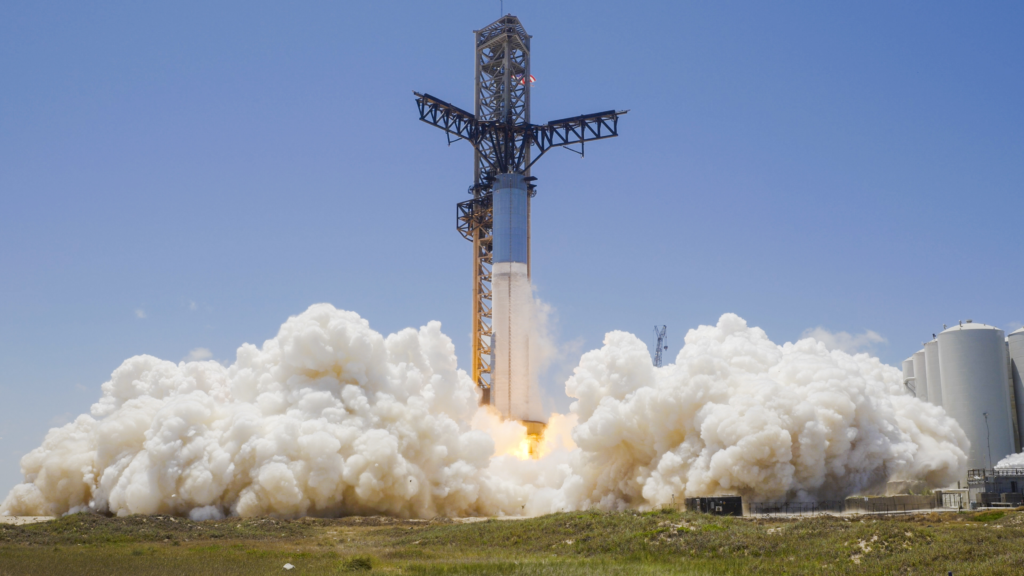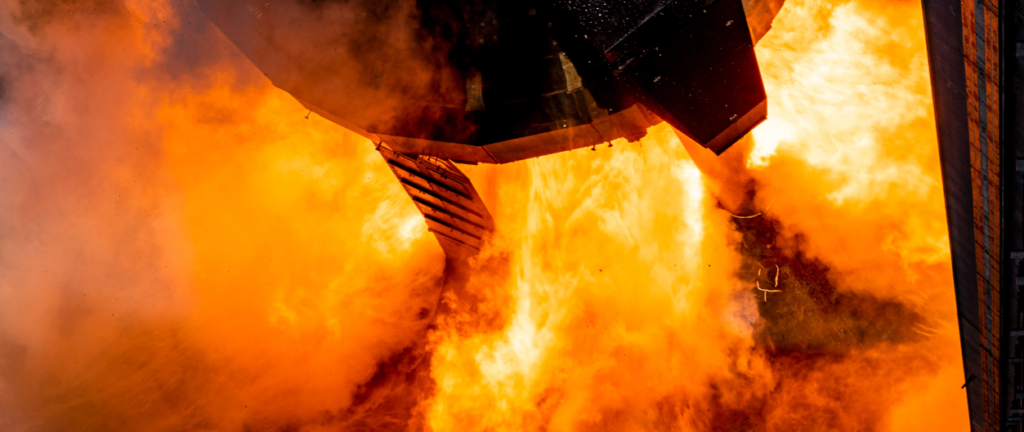
When Will Starship’s Next Launch Attempt Be?
It’s now been around 4 months since Starship’s first integrated test flight and recent developments are suggesting the next attempt will happen very soon. When trying to figure out Starship’s launch date, you need to consider much more than just the rocket’s progress. You also have to factor in Stage 0, the FAA, pre-launch testing, etc. All of which could single-handedly hold back the launch attempt until approved and or ready.
This being said, a successful Booster 9 static fire, deluge system test, filed mishap reports, and now an official launch notice, are all positive steps that happened recently. It’s possible that within the next two months, Starship will be ready to lift off. However, it’s important to point out that a decent bit of work is still left including actual approval, stacking the new hot staging section, and ensuring all systems are ready.
What we can guarantee is that the next few weeks will be action-packed as SpaceX races to finish the rocket and we start to hear more about launch approval and a detailed timeline. Here I will go more in-depth into recent Starship developments, when we can expect the next launch attempt, the upgrades to the vehicle, and more.
Launch Attempt

Just yesterday, a launch notice was released warning of rocket activities in the coming weeks. Based on the wording and timeline, most believe that is talking about an actual launch and not just various testing. Specifically, it was quoted saying, “On August 31st, 2023, mariners operating offshore in waters east of Brownsville, Texas, are advised of rocket launching activities and associated hazardous areas which may impact navigation interests.” It then says, “Mariners should avoid all waters within rocket flight trajectories originating from launch sites and the vicinity of Boca Chica Beach and Brownsville, Texas.”
At first glance, you see this and it suggests that Starship is going to lift off in two weeks at the end of this month. In reality, however, notices like these need to be taken with a grain of salt. They can be amended and also can serve as placeholders as they approach an actual attempt. At the same time, similar notices were issued just weeks before the first attempt in April and served as a hint that the launch was right around the corner. The fact that this was issued right now with a date just a few weeks away is a very good sign that the company is confident Starship is about ready to lift off.
In addition to this launch notice, a few days ago SpaceX officially filed its Mishap report to the FAA. This was the final mishap investigation report to the FAA for its April 20 Starship integrated flight test. “When a final mishap report is approved, it will identify the corrective actions SpaceX must make. Separately, SpaceX must modify its license to incorporate those actions before receiving authorization to launch again,” the FAA said in a statement. With it already being months since the first attempt and activation of the flight termination system, it begs the question of why only now was this submitted and not done months earlier when SpaceX determined exactly what went wrong.
The most realistic case is that the FAA has been closely monitoring and keeping up with the investigation and this official filing is simply a formal closure. In other words, the FAA should already have a bunch of information and insight into the various upgrades and solutions SpaceX has put in place to avoid some of the problems that occurred during the first attempt. The delayed flight termination system activation and pad damage in particular. If this is the case, it shouldn’t take long for the FAA to approve the next launch assuming they are satisfied with the changes SpaceX has made. A case could also be made that SpaceX wanted to wait until the first static fire which showcased the water deluge system to then submit the report with actual hardware and testing to back it up.
Comparing the first launch timeline to this one could also give us an idea of the future plan. Back on February 9th for example, SpaceX ignited 31 of Booster 7’s Raptor engines for a few seconds. Just over two months later on April 20th, the rocket lifted off. Earlier this month on the 6th Super Heavy Booster 9 completed its static fire with similar results. With all things considered a launch around late September to early October seems not only possible but likely.
A New Rocket

The amount of changes to both Starship and the pad from the first launch to now is quite staggering. Ship 25 and especially Booster 9 combine to create a practically different rocket. The pad will also alter the first 10 seconds of launch with possible lasting impacts on the rest of the flight.
Comparing the Booster 7 static fire on the FONDAG concrete to the most recent test helps put in perspective the difference. On the first static fire, you can see engine ignition shoot particles and small pieces of debris in every direction creating large dust clouds. On the more recent test using the steel plate and the deluge system you primarily see mass amounts of steam with big white clouds erupting from under the launch mount. This more similarly resembles other launch vehicles and pads within the industry such as past shuttle launches. Here a massive deluge system and flame trench would work together to protect the pad and rocket from its ignition. It would produce a similar large white plume after the flames make contact with the water.
However, this was only comparing two partial thrust tests that lasted only a few seconds. The real test will be another launch attempt which in theory will reveal a significant improvement. The steel under the pad is not only positioned under the engines but it also stretches between each of the orbital launch mount legs. The steel acts as the main protective barrier whereas the water helps with control the acoustic power of 33 Raptor engines.
You then have a new stage separation approach combined with booster upgrades. Musk said SpaceX made a “tremendous number” of other changes to the vehicle, “well over a thousand.” He also talked about the Raptor engines and SpaceX described the first Starship integrated launch vehicle as using a “hodgepodge” of engines built over time. The Raptors on the new vehicles include changes to the hot gas manifold in the engine to reduce fuel leakage.
Starship’s first test flight was with Booster 7 and Ship 24. Even before the first launch, in an interview, Elon was quoted saying, “We are actually dying to get this rocket off no matter what happens to it because there are so many improvements between booster 7 and booster 9, literally hundreds. Some major ones, we moved from hydraulic thrust vector control to electric, and the entire heat shield structure on the base on Booster 9 is completely redesigned from Booster 7. Booster 7 has kinda a retrofitted heat shield system between the engines”.
Interestingly, a lot of the information and changes that Elon stated prior to the launch, were very relevant during the actual attempt and first flight of Starship. For example, in another interview with Musk, he commented, “Rocket kept going through T+62 seconds” with the engines continuing to run. Lost thrust vector control at T+85 seconds.” Big thing for the next Starship launch is “ensuring that we don’t lose thrust vector control” with Booster 9. We got pretty close to stage separation … if we had maintained thrust vector control and throttled up, which we should have … then we would have made it to staging” he pointed out.
In addition to this, the other big changes that he mentioned before the launch had to do with the booster heat shield and the Raptor engines being like a box of grenades. On Starship’s first flight, we saw some small explosions with the engines during flight and the eventual loss of multiple Raptors. Elon was quoted after the mission saying, ” At T+27 seconds, SpaceX lost communications due to “some kind of energy event.” And “some kind of explosion happened to knock out the heat shields of engines 17, 18, 19, or 20.” This comment from Musk highlights the correlation and value of these changes. In this case, improvements were specifically made to Booster 9 related to this exact problem and protecting the Raptor engines at the base of the rocket.
If the changes mentioned weren’t enough, Elon talked more about the improvements when he said, “The big things that are important for the next flight are, ensuring that we don’t lose thrust vector control, so isolating that thrust vector control. With Booster 9 that is a lot easier because we use electric motors to steer the engines as opposed to hydraulic actuators where you have a common manifold between the hydraulic actuators. In this case, if you lose hydraulic pressure you can lose multiple engines. The electrically actuated engines will be much more isolated and not have like a single event failure as long as they don’t lose power or coms” he said. The hot staging change could also have a big impact considering this area was where the first Starship struggled. Best case scenario the rocket lifts off, doesn’t send debris everywhere, gets through stage separation, and continues on throughout the flight path. The mission profile is very similar to the first attempt so we can hope to see Starship complete each milestone. At the end of the day, as long as Starship doesn’t blow up on the pad and destroy a bunch of infrastructure, SpaceX should gain a lot of valuable information.
Conclusion
There has been quite a lot of launch progress in just the last few days alone. Between filling Mishap reports to launch notices for the end of this month, the pace is picking up around Starbase. We will have to wait and see how it progresses and the impact it has on the space industry.
